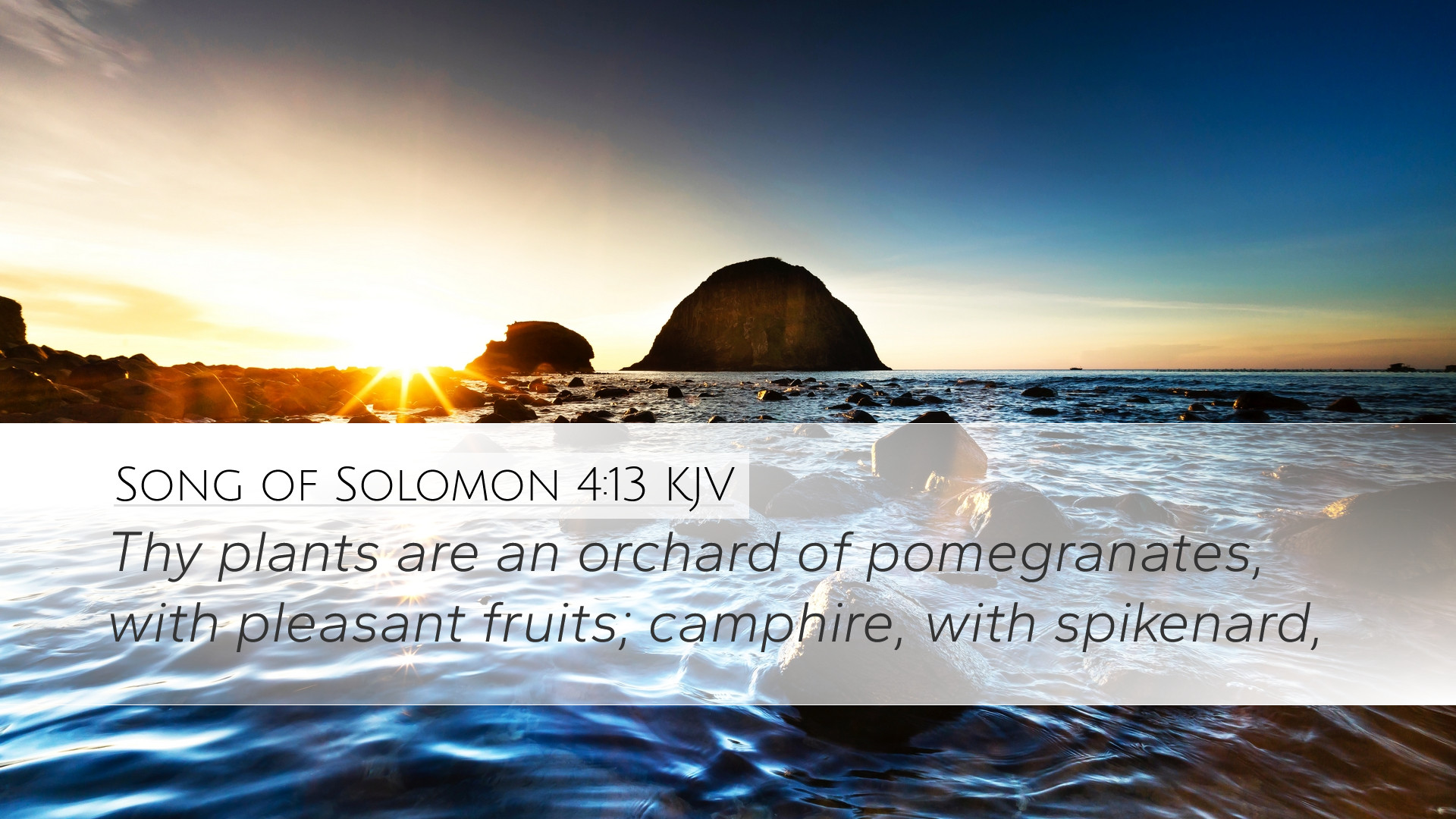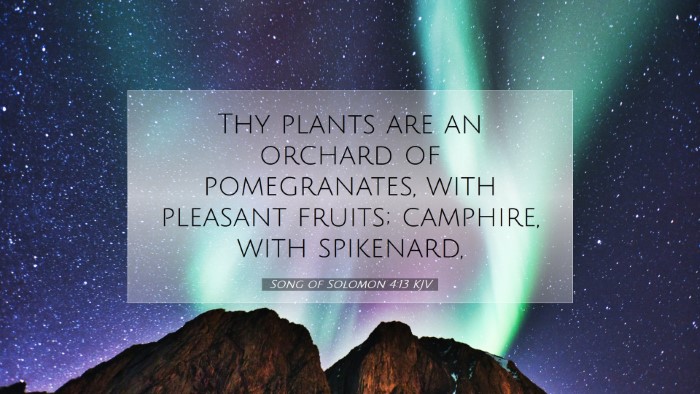Commentary on Song of Solomon 4:13
Verse Text: "Thy plants are an orchard of pomegranates, with pleasant fruits; camphire, with spikenard." (Song of Solomon 4:13, KJV)
Introduction
The Song of Solomon, also known as the Song of Songs, is a rich poetic work attributed to King Solomon. It's often interpreted as an allegory of God's love for His people or as a celebration of romantic love between a bride and groom. Chapter 4 in this text is particularly intimate, with imagery that conveys both beauty and abundance. This commentary will explore the significance of Song of Solomon 4:13 through the insights of public domain commentaries.
Analysis of Key Themes
-
The Metaphorical Garden:
Matthew Henry emphasizes the metaphor of a garden that blooms with various fruits, which symbolizes the delights and richness of love. The imagery of the garden suggests purity, beauty, and the fullness of relationships, highlighting the ideal state of love.
-
Symbolism of Pomegranates:
Albert Barnes notes that pomegranates are often associated with fertility and prosperity in biblical literature. Their abundance in the verse signifies the fruitful nature of the beloved's character and the richness of love shared between the lovers.
-
Variety in Love:
Adam Clarke points out that the mention of various fruits, including camphire and spikenard, illustrates the diversity of love's experiences. The different spices and flowers symbolize the multifaceted nature of intimacy, desire, and passion within a relationship.
Detailed Exegesis of the Verse
“Thy plants are an orchard of pomegranates...”
This opening phrase establishes the beloved as a garden rich in fruits, emphasizing the idea of cultivation and care in relationships. The term 'plants' suggests something that is actively tended, reflecting the nurturing aspect of love.
“...with pleasant fruits;”
The use of 'pleasant fruits' conveys a sense of enjoyment and satisfaction in relationship dynamics. It signifies not only physical intimacy but also emotional and spiritual sweetness that comes from a loving bond.
“...camphire, with spikenard.”
Camphire, often identified with the cyprus tree or various aromatic plants, adds a layer of fragrance and allure to the gifts of the beloved. Spikenard, known for its precious aroma, evokes the richness of love, connectedness, and desire. The choice of these specific plants underlines the beauty and preciousness of the relationship described in the Song of Solomon.
Spiritual and Theological Insights
-
God's Love as a Garden:
Henry later draws parallels between the garden imagery and God's love for His people. Just as a garden nourishes and sustains, so does divine love provide abundance and spiritual nourishment. This verse reflects God's desire for intimacy and fruitfulness in the lives of His followers.
-
Reflection of Christ and the Church:
Barnes and Clarke also suggest that the sensual imagery is representative of the profound relationship between Christ and the Church. The 'orchard of pomegranates' suggests the Church as a vibrant community filled with life and spiritual gifts, sustained by Christ's love.
Practical Application for Believers
Understanding the depth of Song of Solomon 4:13 can have significant implications for personal relationships and spiritual lives. Here are some practical takeaways:
- Embrace Nurturing Relationships: Like a well-tended garden, relationships require care, attention, and intentionality. Cultivating emotional and spiritual connections can lead to abundant love.
- Explore the Diversity of Love: Recognizing that love can take many forms—romantic, platonic, and familial—can enhance the appreciation of those relationships. Each type offers different fruits that lead to a fuller experience of life.
- Reflect on God’s Abundance: Believers are encouraged to see God’s love as a plentiful garden that seeks to feed and nourish their souls. This perspective can transform the way one perceives trials and challenges by recognizing the underlying presence of divine love and provision.
Conclusion
Song of Solomon 4:13 artfully illustrates the richness and diversity of love through its vivid imagery. The insights provided by Matthew Henry, Albert Barnes, and Adam Clarke collectively enhance our understanding of the verse. They allow readers to appreciate not only the romantic connotations but also the broader themes of nurturance, spiritual abundance, and God's loving relationship with humanity. This commentary invites pastors, theologians, and students to delve deeper into the nuances of love that permeate the Scriptures, leading to a greater comprehension of both human and divine intimacy.


